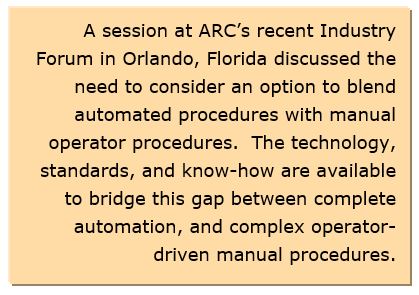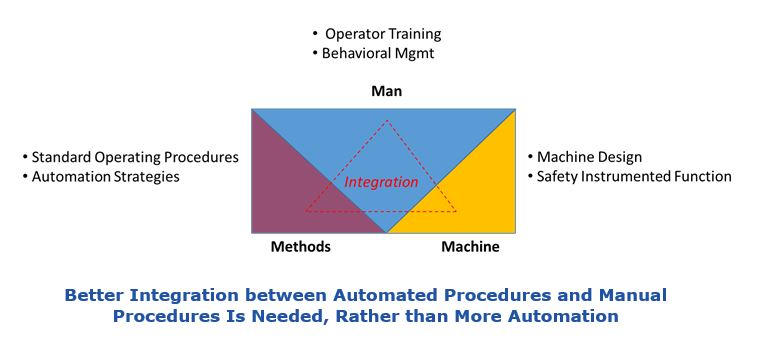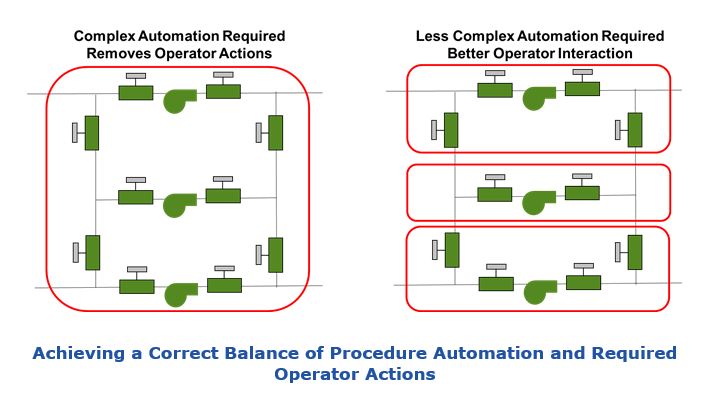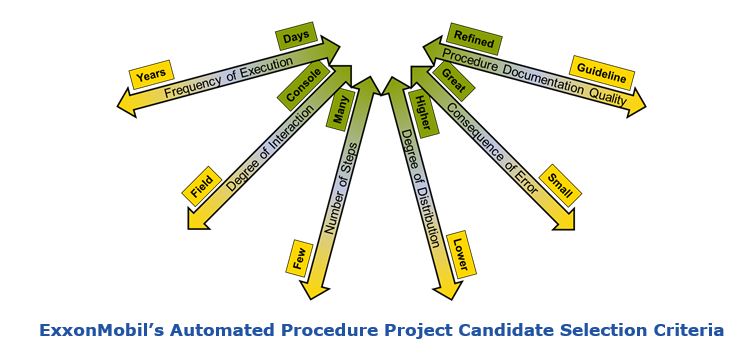

Across the process industries many plants are still using paper-based procedures, or the digital equivalent, to guide employees through critical transitions, such as process startups, shutdowns, and product grade changes. Often, the procedures have not been 
A session at ARC’s recent Industry Forum in Orlando, Florida discussed the need to consider an option to blend automated and manual procedures. Technology, standards, and know-how are now available to bridge the gap between fully automated and fully manual procedures. By partially automating highly complex procedures, plants can ensure that procedures that might be too complex for either the control system or the operator to perform independently will be performed safely, efficiently, and in the correct sequence.
The session featured examples of how to utilize standards such as ISA106 and ISA88 as well as project approaches that offer the potential to reduce operator error while keeping the plant operators fully engaged in running the operations.
For several decades now, the process industries have been working diligently to eliminate incidents and accidents caused by human error. Though operator training and documentation for manual procedures have improved over the years, the fundamental fact remains that operators do not always follow procedures. Statistics show that 45 percent of all abnormal incidents are caused directly by human error. In addition, if you include human causes related to the other two factors – premature equipment failure or production upsets – the total impact of human error would be closer to 65 to 70 percent.
The decades-long approach in the automation industry has been to reduce the need for operator action by completely automating complex tasks. Initially, this approach helped; but since 2010 no significant improvement has been made in reducing incidents and accidents. If anything, the incidents that do occur have become more severe.

The premise of this ARC Forum session was that the process industries need to take a new approach. Increasingly, complex automation has reached the point of diminishing returns. What is needed is a higher level of functional integration between automation and operators for those challenging procedures that might be too complex for either to handle independently.
Laura Sheets, Tritium Process Control Lead Engineer at Savannah River Nuclear Solutions, explained that the Savannah River site is tasked with protecting the public’s health and environment by safely processing spent nuclear materials for the US Navy and other government entities. The operators at the site are responsible for the safe operation of the facility and the control system aids the operators to ensure that procedures are utilized in the process of handling nuclear waste. However, Ms. Sheets provided examples, both personal and professional, to support her contention that “No matter how simple the procedure and how long they have been doing it, people are bad about exactly keeping track of, and following every step.”
The management team at Savannah River recognized this and began to convert the written procedures to ones that incorporated the right amount of automation. The goal was to continue to have the operators “drive” the processes, but to do so assisted by the automation. For example, in the past, operators would have to manually line up valves and turn on pumps to transfer material from one vessel to another. Often, these had multiple (redundant) lines in case a pump or valve was malfunctioning or out of service.

Initially management thought it would be best to make all the pumps and related valves into one large group. In this manner, it would be possible to have two pump trains running simultaneously, and the middle train could substitute for either if one is down for maintenance. However, this got so complicated that they decided to make three automated groups rather than one large group. This had the added benefit of being able to reuse the basic steps for the pump trains elsewhere. This also enabled the right level of operator interaction with the automated procedure.
Ms. Sheets made the analogy of operating a vehicle prior to the advent of today’s GPS technology. With a GPS, the “operator” of the vehicle is still “driving,” but the GPS helps ensure that the vehicle follows the best path to achieve the goal.
Tom Kendi, Technical Lead, Procedural Automation at ExxonMobil Research and Engineering, indicated that they believe that automated procedures should be applied in two cases. The first would be cases in which there are changes of state, such as grade changes, “safe park,” or blocked operations transition. The second case would be when interactive procedures are required, such as with cyclic processes, catalyst regeneration, decoke or catalyst switch applications. ExxonMobil’s goal is to make sure that “every operator will perform like the best operator on his or her best day.”
The library of modules developed by ExxonMobil for automated procedures has evolved over the past 10 to 15 years. These are not limited to batch or sequential processes, but can also apply to continuous processes. Like others in this session, Mr. Kendi pointed out that it is not cost-effective or feasible to automate all procedures. The company has developed guidelines as to how to decide if a procedure should be automated.

Approval for Automated Procedure projects tend to favor situations in which execution is more frequent, integration with console operators is important and pervasive, there are many steps, the degree of distribution is high, consequences of an error are great, and the existing procedure is well established. These attributes tend to make the automated procedure more successful from both an operational and investment perspective.
Technology has advanced to the point whereby automated procedures are possible in most if not all process plants that already have control systems running the process. However, it is important to strike the right balance between operator responsibilities and what an automated procedure can do. The best combination seems to be ones that allow the operator to stay focused on running the plant, while the automated procedure attends to procedural details that are easy to miss.
Furthermore, once a company starts to look at potential opportunities to automate procedures, it is likely that there will be more opportunities than funding to accomplish all. Therefore, it is important to develop a process to evaluate potential procedural automation projects in a way that improves productivity, lowers incidents and production outages, while at the same time provides an economic return on the investment.
Based on ARC research and analysis, we recommend the following actions for owner-operators and other technology users:
If you would like to buy this report or obtain information about how to become a client, please Contact Us
Keywords: ISA 106, Manual Procedures, Automated Procedures, Human Error, ARC Advisory Group.

